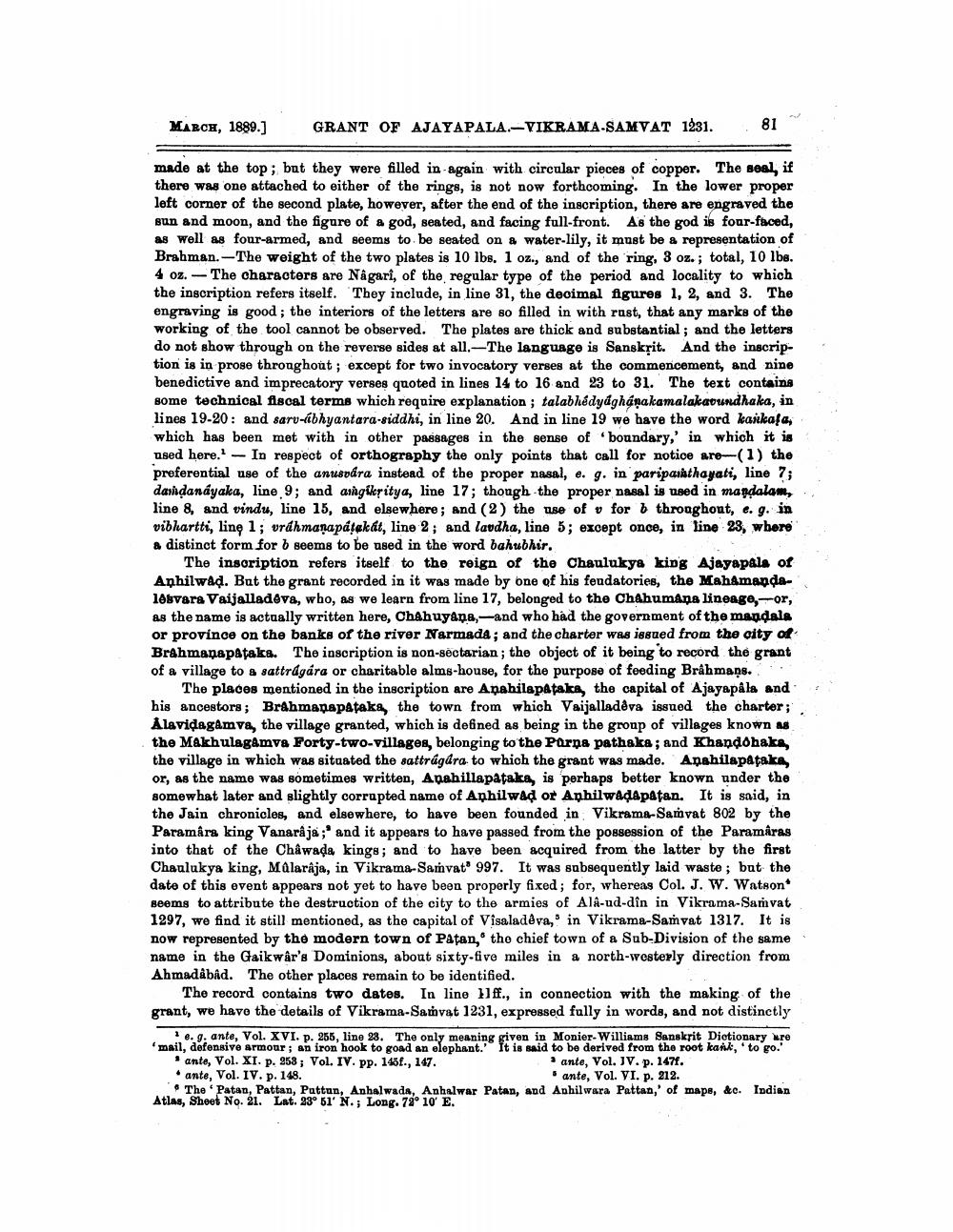________________
MARCH, 1889.)
GRANT OF AJAYAPALA.-VIKRAMA-SAMVAT 1231.
81
made at the top; but they were filled in-again with circular pieces of copper. The seal, if there was one attached to either of the rings, is not now forthcoming. In the lower proper left corner of the second plate, however, after the end of the inscription, there are engraved the sun and moon, and the figure of a god, seated, and facing full-front. As the god is four-faced, as well as four-armed, and seems to be seated on a water-lily, it must be a representation of Brahman. -The weight of the two plates is 10 lbs. 1 oz., and of the ring, 3 oz.; total, 10 lbs. 4 oz. — The characters are Nagari, of the regular type of the period and locality to which the inscription refers itself. They include, in line 31, the decimal figures 1, 2, and 3. The engraving is good ; the interiors of the letters are so filled in with rast, that any marks of the working of the tool cannot be observed. The plates are thick and substantial; and the letters do not show through on the reverse sides at all. -The language is Sanskrit. And the inscription is in prose throughout; except for two invocatory verses at the commencement, and nine benedictive and imprecatory verses quoted in lines 14 to 16 and 23 to 31. The text contains some technical fiscal terms which require explanation ; talabhédydghánakamalakasundhaka, in lines 19-20: and sarv-abhyantara-siddhi, in line 20. And in line 19 we have the word kaikafa which has been met with in other passages in the sense of boundary,' in which it is used here. In respect of orthography the only points that call for notice are-(1) the preferential use of the anuspára instead of the proper nasal, e. g. in pariparathayati, line 7; dardanayaka, line 9; and anngiksitya, line 17; though the proper nasal is need in mandalam, line 8, and vindu, line 15, and elsewhere; and (2) the use of v for b throughout, e. g. in vibhartti, line 1; vráhmanapátekát, line 2; and lavdha, line 5; except once, in line 23, where a distinct form for b seems to be used in the word bahubhir.
The inscription refers itself to the reign of the Chaulukya king Ajayapals of Anhilwaq. But the grant recorded in it was made by one of his feudatories, the Mahamanda10vara Vaijalladeva, who, as we learn from line 17, belonged to the Chahumana lineage, or, as the name is actually written here, ChAhuyana-and who had the government of the mandala or province on the banks of the river Narmada; and the charter was issued from the city of Brahmanapatake. The inscription is non-sectarian; the object of it being to record the grant of a village to a sattrágára or charitable alms-house, for the purpose of feeding Brahmans.
The places mentioned in the inscription are Anahilapatake, the capital of Ajayapala and his ancestors ; Brahmanapatake, the town from which Vaijalladeva issued the charter; Alavidagamva, the village granted, which is defined as being in the group of villages known as the Makhulagamve Forty-two-villages, belonging to the Parna pathaka; and Khandohaka, the village in which was situated the sattrúgára to which the grant was made. Apahilapataka, or, as the name was sometimes written, Anahillapataka, is perhaps better known under the somewhat later and slightly corrupted name of Anhilwad or Anhilwadapatan. It is said, in the Jain chronicles, and elsewhere, to have been founded in Vikrama-Samvat 802 by the Paramâra king Vanarâja ;' and it appears to have passed from the possession of the Paramaras into that of the Châwada kings; and to have been acquired from the latter by the first Chaulukya king, Mâlarâja, in Vikrama-Samvat 997. It was subsequently laid waste; but the date of this event appears not yet to have been properly fixed; for, whereas Col. J. W. Watson seems to attribute the destruction of the city to the armies of Ald-ud-dîn in Vikrama-Samvat 1297, we find it still mentioned, as the capital of Visaladeva, in Vikrama-Samvat 1317. It is now represented by the modern town of Patan, the chief town of a Sub-Division of the same name in the Gaikwâr's Dominions, about sixty-five miles in a north-westerly direction from Ahmadabad. The other places remain to be identified.
The record contains two dates. In line ff., in connection with the making of the grant, we have the details of Vikrama-Samvat 1231, expressed fully in words, and not distinctly
ente, Vol. XVI. p. 265, line 23.
a an elephant. It is said
ante. Vol. IV. p. 147f.
Ie. . ante, Vol. XVI. p. 256, line 23. The only meaning given in Monier-Williams Sanskrit Dictionary Mre 'mail, defensive armour; an iron hook to goad an elephant. It is said to be derived from the root kank, 'to go.'
* ante, Vol. XI. p. 958; Vol. IV. pp. 145., 147. • ante, Vol. IV. p. 148.
ante, Vol. VI. p. 212. The Patan, Pattan, Pattan, Anhalwada, Anhalwar Patan, and Anhilwara Pattan,' of mape, &c. Indian Atlas, Sheet No. 21. Lat. 23° 51' N.; Long. 74° 10' E.




